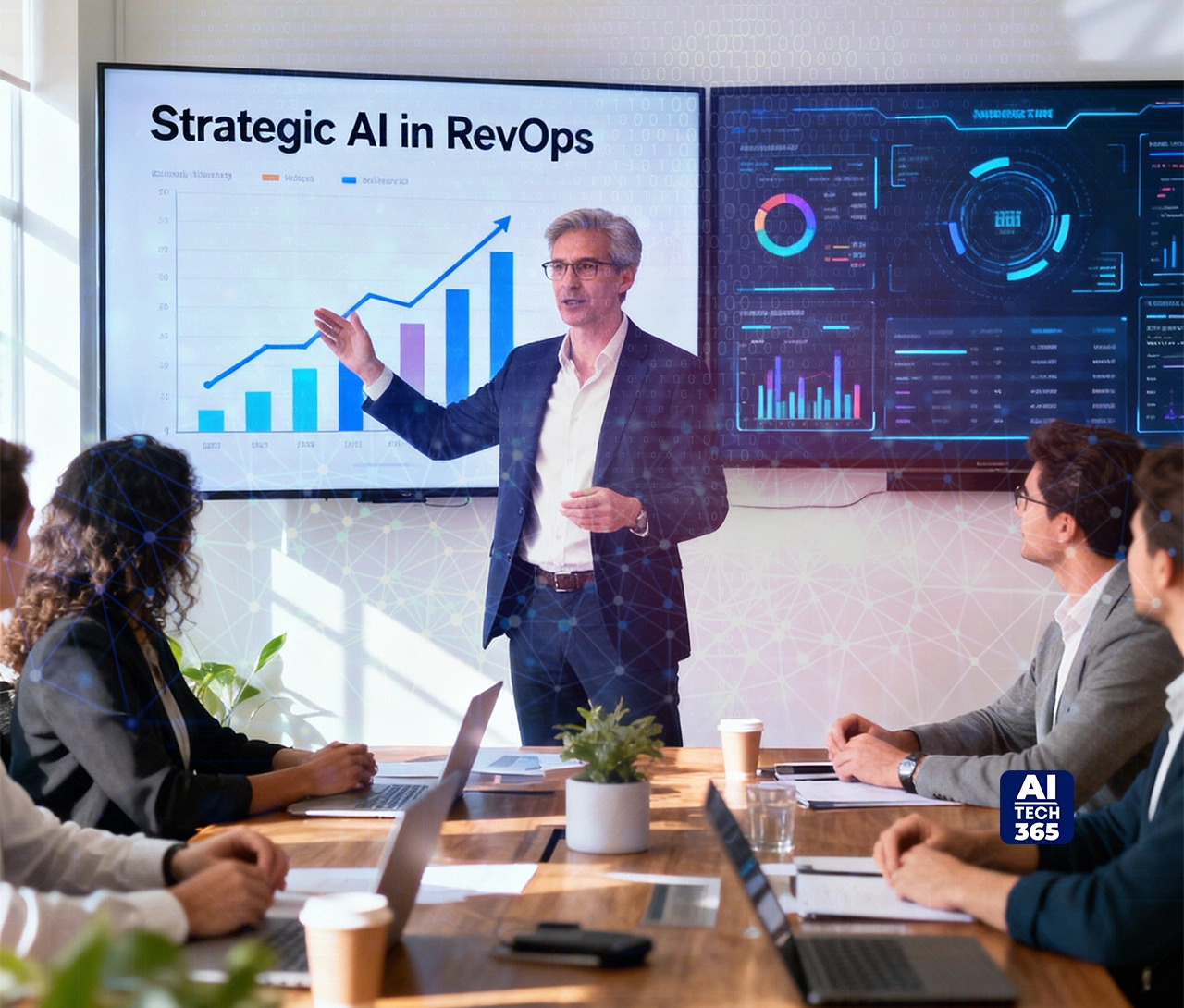Revenue operations is supposed to make marketing, sales, and customer success work together. In reality, they rarely do. Marketing hands off leads too late, sales lose signals, and customer success is constantly trying to rectify the situation. Data seems to be available everywhere yet is also the same amount of time nowhere. Lists are copied, systems are unable to communicate, and manual transfers cause everything to be delayed. That is the challenge.
AI is not here to replace humans. It is here to make the system work. It can unify data across platforms, clean up errors, and fill in the gaps. It can optimize processes and even predict outcomes before they happen.
This playbook is about making AI work for revenue operations. We focus on three things. First, building a clean and trusted data foundation. Second, automating the funnel from lead to renewal. Third, using AI to forecast revenue and make smarter decisions. It is practical, tactical, and designed to show real results.
The Foundation for AI-Driven Data Unification and Hygiene

Data is everywhere and it is a mess. Marketing has its lists, sales has theirs, customer success has their own. Every team thinks their system is right. The problem is, no one talks to each other. Reports are wrong, handoffs are clunky, opportunities get lost. You need a single source of truth. That means marketing automation, CRM, and customer success tools all feeding into one clean picture. Master data management is the backbone here. It makes sure the records are complete. It makes sure they are correct. It makes sure they can actually be used.
AI helps make this real. It scans through all the duplicates, messy accounts, and overlapping contacts. It figures out what to merge and what to keep. It does it fast and with precision. Then it looks at the gaps. Missing job titles, missing company info, missing intent signals. It fills them in automatically. Salesforce Data Cloud is proof this works. Their AI and Data Cloud revenue passed $1 billion and grew 120 percent in a year. Companies trust it to clean huge datasets and make them usable.
Also Read: AI Transparency vs. AI Performance: The Trade-Off Leaders Must Manage
But clean data is only half the story. Trust matters. You need to know which records are solid and which ones are shaky. AI can give each record a quality score. Marketing, sales, and customer success can then focus only on data they can rely on. This reduces mistakes. It makes reports believable. It is the case that the decisions are made in a faster and more intelligent way.
In case your data has been made to be one, has been cleaned, has been enriched, and has been given a score of trust, then all the rest is easier. Lead transfer from marketing to sales is smoother. Customer success can act before churn happens. Forecasts become believable. And that is when AI RevOps automation stops being just a buzzword. It becomes the engine that actually moves revenue.
III. Tactical Automation Across the Revenue Funnel
Marketing, sales, and customer success all touch the same revenue engine. But if the handoffs are messy, deals stall, and opportunities get lost. That is why AI matters. It can take over the boring parts, the repetitive checks, and the guesswork. It does the heavy lifting so humans can focus on the decisions that matter.
Start with marketing to sales. Lead scoring is more than simple rules. AI looks at history. It looks at web activity, engagement signals, and intent data. It can predict which leads are actually likely to convert. OpenAI shows how this scales. Over 1 million businesses use ChatGPT for Work or the API to power smarter handoffs and better lead engagement. AI can instantly route leads to the right rep. Not just round-robin. But based on territory, capacity, and fit. Leads go where they can actually move. No waiting, no confusion.
Sales is next. Deals stall for many reasons. AI can monitor the health of every opportunity. It reads call transcripts, emails, engagement metrics, and flags risks early. It can even suggest the next best action. Send a case study. Schedule a meeting. Nudge the customer. Salesforce Agentforce proves this works at scale. In Q4 FY25, it handled 380,000 conversations with an 84 percent resolution rate and only 2 percent needed escalation. That is precision and speed humans cannot match alone.
Customer success is the final leg. Churn happens fast. AI watches usage patterns, support ticket sentiment, and payment behavior to spot at-risk accounts before they slip away. It can also find opportunities to upsell or cross-sell by matching customer data to product gaps. HubSpot’s Breeze Customer Agent shows the impact. It resolves over 50 percent of support tickets and users spend nearly 40 percent less time closing tickets. Teams get the information they need, faster. Customers feel taken care of. Revenue grows.
When all three functions use AI together, the revenue funnel moves smoother. Leads are qualified and routed instantly. Sales reps are more effective and deals close faster. Customer success teams intervene before churn and uncover expansion opportunities. This is AI RevOps automation in action. It is not theory. It is practical. It is measurable. It turns fragmented processes into a streamlined, revenue-generating engine.
Strategic AI for Forecasting and Deal Intelligence

Automation gets the day-to-day done. Strategic AI gets the big picture right. Once your data is clean and your funnel is moving, you need to know what is coming next. That is where AI-driven forecasting steps in. Traditional roll-up forecasting can only do so much. You take last quarter, average it, maybe add a little gut feel. AI does something different. It looks at time-series data, historical trends, even how your reps are interacting with customers. It spots patterns humans might miss. It gives you a prediction that is grounded in reality, not just hope. Microsoft proves this at scale. Their AI business has reached a $13 billion annual revenue run rate, up 175 percent year over year. That shows organizations trust AI to power their revenue decisions and not just the operational stuff.
Scenario planning becomes simple. You can ask, what happens if this segment slows down or that product spikes in demand. AI runs the numbers instantly and shows the impact on the forecast. You can see different outcomes and plan accordingly. No more waiting for spreadsheets or manual adjustments.
Forecasting is only one part. You need to understand why deals win or lose. AI can analyze conversation sentiment, deal history, and engagement metrics to pinpoint root causes. Maybe a stage is slowing things down. Maybe a key handoff is leaking leads. Process bottlenecks are revealed without the guesswork. This lets RevOps teams focus on fixing the right issues first.
The combination of forecasting and deal intelligence creates clarity. You know not just what is likely to happen but why it happens. You see where the process drags, which accounts need attention, and where to focus for growth. It turns subjective guesses into actionable insights. Teams can prioritize, reps can act, and leadership can trust the numbers.
This is the power of strategic AI. It moves revenue planning from reactive to proactive. From messy and uncertain to precise and informed. AI RevOps automation is no longer just a tool for operational efficiency. It becomes the engine behind confident decision-making, predictable growth, and a smarter revenue strategy.
Building Your AI RevOps Roadmap
We have covered a lot. At the core, there are three pillars. First, data trust. Your decisions are only as good as your data. Second, funnel speed. Leads, deals, and customer interactions need to move fast without getting stuck. Third, predictive strategy. AI gives you foresight, not guesswork, so you can act before problems appear
Getting there is a phased journey. Phase one is data audit and cleaning. Make sure everything is accurate and complete. Phase two is tactical automation. Lead scoring, routing, next-best-action, get AI handling repetitive tasks so teams can focus on high-value work. Phase three is strategic implementation. Forecasting, scenario planning, deal intelligence, use AI to guide decisions and strategy.
Remember, AI RevOps automation is not a project you finish once. It is a cycle. Iterate, improve, and make the revenue operations smarter, faster, and more predictable.


